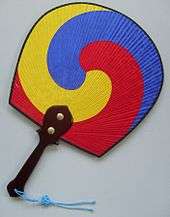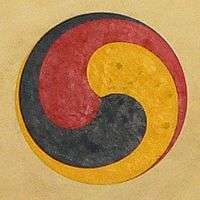Taegeuk
Taegeuk (Korean: 태극; Hanja: 太極, Korean pronunciation: [tʰɛgɯk̚]) is a traditional Korean symbol. The word is cognate with the Chinese term Taiji (old spelling "Taichi"), meaning "supreme ultimate".[1][2] The symbol was chosen for the design of the national flag in the 1880s, known as taegeukgi (Hangul: 태극기, with gi meaning "flag").[3] The Taegeuk is commonly associated with Korean tradition and represents balance in the universe: the red half represents positive cosmic forces, and the blue half represents the opposing negative cosmic forces. It is used in Korean Shamanism, Confucianism, Daoism and Buddhism.[4][5]
| Taegeuk | |
 The taegeuk found on the flag of South Korea. | |
| Korean name | |
|---|---|
| Hangul | 태극 |
| Hanja | 太極 |
| Revised Romanization | Taegeuk |
| McCune–Reischauer | T'aegŭk |
History
The Taegeuk has been in use for the majority of written history of Korea.[6] The origins of the interlocking-sinusoid design can be traced to as early as the Goguryeo or Silla period, e.g. in the decoration of a sword, dated to the 5th or 6th century, recovered from the grave of Michu of Silla,[7] or an artifact with the a Taegeuk pattern of similar age found in the Bogam-ri tombs of Baekje at Naju, South Jeolla Province in 2008.[8][9] In the compound of Gameunsa, a temple built in AD 628 during the reign of King Jinpyeong of Silla, a stone object, perhaps the foundation of a pagoda, is carved with the Taegeuk design.[3][10]
In Gojoseon, that is the ancient kingdom of Joseon, the design was used to express the hope for harmony of yin and yang.[3][11]
Today the Taegeuk is commonly associated with Korean tradition and represents balance in the universe: the red half represents positive cosmic forces, and the blue half represents the opposing negative cosmic forces. It is used in Korean shamanism[4][5]
South Korean flag

The Taegeuk symbol is most prominently displayed on South Korea's national flag, called the taegeukgi (along with four of the eight trigrams used in divination). Because of the Taegeuk's association with the national flag, it is often used as a patriotic symbol, as are the colors red, blue, and black. The “geon” trigram (☰) represents the heaven, spring, east, and justice. The “gon” trigram (☷) symbolizes the earth, summer, west, and vitality, the “gam” trigram (☵) the moon, winter, north, and wisdom, and the “ri” trigram (☲) the sun, autumn, south, and fruition. The four trigrams supposedly move in an endless cycle from “geon” to “ri” to “gon” to “gam” and back to “geon” in their pursuit of perfection.[12] The white background symbolizes the homogeneity, integrity and peace-loving nature of the Korean people. Traditionally, Koreans often wore white clothing, earning the nickname “white-clothed people” and therefore the color white epitomizes the Korean people.[6][12]
Variants
Tricolored Taegeuk

A popular variant in South Korea is the tricolor Taegeuk (samsaeguitaegeuk 삼색의태극 or samtaegeuk 삼태극), which adds a yellow lobe or "pa" (hanja: 巴 Hangul: 파). The yellow is taken as representing humanity, in addition to the red and blue representing earth and heaven respectively. This version is related to the Tibetan & Korean Buddhist symbol of Gankyil.
A rendition of the tricolored Taegeuk also appeared in the official logo of the 1988 Summer Olympics accompanied by the five Olympic rings.[13] A similar symbol is used by the Miss Asia Pacific World Beauty Pageant, which was hosted in South Korea from its inception in 2011 until 2014, and most recently hosted in Australia in 2018.
Paralympics symbol

The first designated Paralympic logo, created for the 1988 Summer Paralympics in Seoul, was based on the traditional pa (Hangul: 파 hanja: 巴), the spiral or sinusoid components making up the Taegeuk symbol. In March 1992,[14] the Paralympic symbol was changed to a version utilizing only three pa. This was not fully adopted until after the 1994 Winter Paralympics in Lillehammer, Norway, since the Lillehammer Paralympic Organizing Committee had by then already started a marketing program based on the five-pa version. The three-pa version remained in place from the close of the Lillehammer Games through the 2004 Summer Paralympics in Athens, Greece.[15][16]
Gallery
 Taegeuk pattern painted on the gate of a house in Naju
Taegeuk pattern painted on the gate of a house in Naju Three-color Taegeuk on a buk (drum)
Three-color Taegeuk on a buk (drum) Three-color Taegeuk encircled by pal gwae.
Three-color Taegeuk encircled by pal gwae.
See also
References
- Gukgiwon (국기원) (2005). Taekwondo textbook. Seoul: 오성출판사. p. 303. Retrieved 2 March 2016.
- Rogers, William Elford (1994). Interpreting Interpretation: Textual Hermeneutics as an Ascetic Discipline. University Park, Pa: Pennsylvania State University Press. p. 303. ISBN 9780271010618. Retrieved 2 March 2016.
- Korean overseas information service (2003). Handbook of Korea (11. ed.). Seoul: Korean Overseas Information Service. p. 568. ISBN 9788973750054. Retrieved 3 March 2016.
- Kim, Sang Yil; Ro, Young Chan (1984). Hanism as Korean mind : interpretation of Han philosophy. Los Angeles, Calif.: Eastern Academy of Human Sciences. p. 66. ISBN 0932713009. Retrieved 2 March 2016.
- Korea's Sam-Taegeuk Symbol. san-shin.org, dedicated to the sacred mountains of Korea.
- Islam, M. Rafiqul (2014). Unconventional Gas Reservoirs: Evaluation, Appraisal, and Development. Elsevier. p. 352. ISBN 9780128005941. Retrieved 3 March 2016.
- Proceedings of the International Symposium on Cultivation and Utilization of Asian, Sub-tropical, and Underutilized Horticultural Crops: Seoul, Korea, August 13–19, 2006 (2011), p. 48
- 국내 最古 태극무늬, 1400년 만에 햇빛 Dong-A Science, Yoon wan-jun, 2009-06-04
- "Oldest Taegeuk Pattern Found in Naju". Koreatimes.co.kr. 2009-06-03. Retrieved 2013-01-12.
- 경주감은사지 Encyclopedia of Korea
- An Illustrated Guide to Korean Culture - 233 traditional key words by The National Academy of the Korean Language
- Ludden, Ken (2010). Mystic Apprentice Volume 3: Meditative Skills with Symbols and Glyphs Supplemental. p. 131. ISBN 9780557728503. Retrieved 3 March 2016.
- http://www.aldaver.com/Images/Os/lg1988sm.gif
- Vom Rehabilitationssport zu den Paralympics Archived 2012-03-05 at the Wayback Machine (German), Sportmuseum Leipzig
- "New Logo and Motto for IPC". International Paralympic Committee. 2003. Archived from the original on 6 April 2008. Retrieved 18 August 2015.
- International Paralympic Committee - The IPC logo, motto and flag, CRWFlags.com
External links
| Wikimedia Commons has media related to Taegeuk. |
| Wikimedia Commons has media related to Sam Taegeuk. |